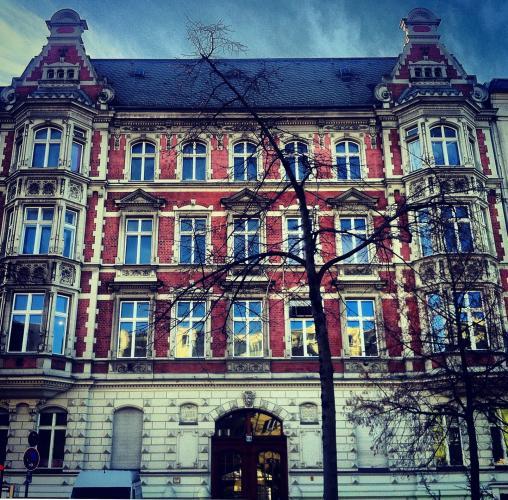Pre-interview: Steffen Bunte
Pre-interview: Steffen Bunte
Faced with a too-big apartment for the two of them, Hannes Schroeder-Finckh of Sprueth Magers and NickKoenigsknecht of Peres Project did what came naturally: turned it into an art space. The result is Open Forum (formerly, the eponymous KSF Project Space), and the duo are ready to debut Berlin-based Steffen Bunte’s ‘Kill Switch’.
Working in a multimedia scape, Bunte’s work explores the fraying boundaries between technology and ourselves. Referencing Jeopardy’s Watson and Honda’s Asimo, the 21st-century space race is in full view in Bunte’s first solo show in Berlin. Yet, this is not a race to the moon, but rather to the point of perfect digital representation/replication of ourselves. With digital evolution pushing for programs and products that can outsmart their makers, I met with Koenigsknecht and Bunte at Open Forum to discuss ‘Kill Switch’, Open Forum, and our inevitable digital armageddon.

Image contributed by Open Forum
NM: How do you feel about the arguably inevitable digital armageddon? Is it terrifying, amazing, exciting, or otherwise?
SB: I think it’s both exciting and terrifying. I am always amazed of machinery, but when you have this idea of machines becoming smarter than yourself, you get more powerful [yourself] in a way. For me, I guess, I can’t really give an answer yet - I am still puzzled about being amazed and terrified at the same time.
NM: How did you get started into this particular curiosity? It is a pretty specialized interest group.
SB: It actually all started with my interest in the NASA Mission - Curiosity. They sent a robot - the size of a small car - up to Mars, and it was to find out more about the planet: What is it made of? What is on it?I started following all of this, and found that this machine actually has a camera on it, and NASA uploads all the images from [the camera]. This was a remote robot that created images. This was something I wouldn’t expect from a machine.
NK: It creates images and aesthetics.
SB: And aesthetics, actually! When I think of aesthetics, I only think of things created by humans. These machines accidentally created something human-like.
NM: The idea of Watson is also interesting in that human-like way.
NK (referencing three large-scale screenprints of forged Jeopardy screenshots): [The way Jeopardy clues are phrased] is funny because it’s one of those things that is a textual joke, but it’s not really funny. Jeopardy as a format is really interesting, especially about artificial intelligence. Computers are based on the idea of you submitting a query and getting an answer. This is the exact opposite: you submit the answer, and the computer has to come up with a query. That’s another reason why Watson was such a big step for artificial intelligence - it wasn’t just answering questions. It was figuring out what would elicit this response [from the Jeopardy clues].
SB: It is a creative way of using language. You have to be able to interpret language, and language itself is a pretty hard thing for a machine to understand in the question-answer format alone.
NM: And, once a machine understands language, how do you teach a machine to understand puns?
SB: Exactly!
NM: Wrapping up, in addition to ‘Kill Switch’, you have a few more shows coming up in the future, and they are all group shows. In terms of preparation, how does the preparation for those shows differ from what you have been working on in and at Open Forum?
SB: It’s just a different approach, actually. With group shows, I haven’t that much experience. I actually have more experience with solo shows at the moment. A solo show is just so much more intense. For the last group show I did, I actually never went to New York - I just sent some mail out and it went well, so…
NK: Steffen has basically been living here - I mean, in Berlin, too, but also IN this space. That’s something that’s unique to our situation. We live here. To me, there’s something exciting about the idea of artists working in my home. They’re able to live in the space and figure out how to relate to it. With younger artists with less experience doing shows, the space is often times thought about in a confrontational way. If you listen to the way artists approach spaces, they’re like, “I had to conquer that space”, or, “I had to challenge that space”. The initiative here was to give that opportunity to really offer every opportunity needed to tackle this space successfully.
[Artists] can stay here; they have the key. There’s no turning the work in the day before, or showing up and finding where your work will be. The whole idea of this forum is to give artists to put their best foot forward and give them all the resources possible to accomplish that. It’s not just a financial thing. It’s a time thing.
NM: Seeing shows are not scheduled on an annual cycle, and there is more flexibility with openings of shows, there is a lot more freedom in the Open Forum programming for deadlines. When was this work finished?
SB: (laughs)
NK: Fifteen minutes before you showed up.
‘Kill Switch’ by Steffen Bunte opens on 25.04 at 19h at Open Forum, and is on display until 01.06 by appointment only. More information can be found here.